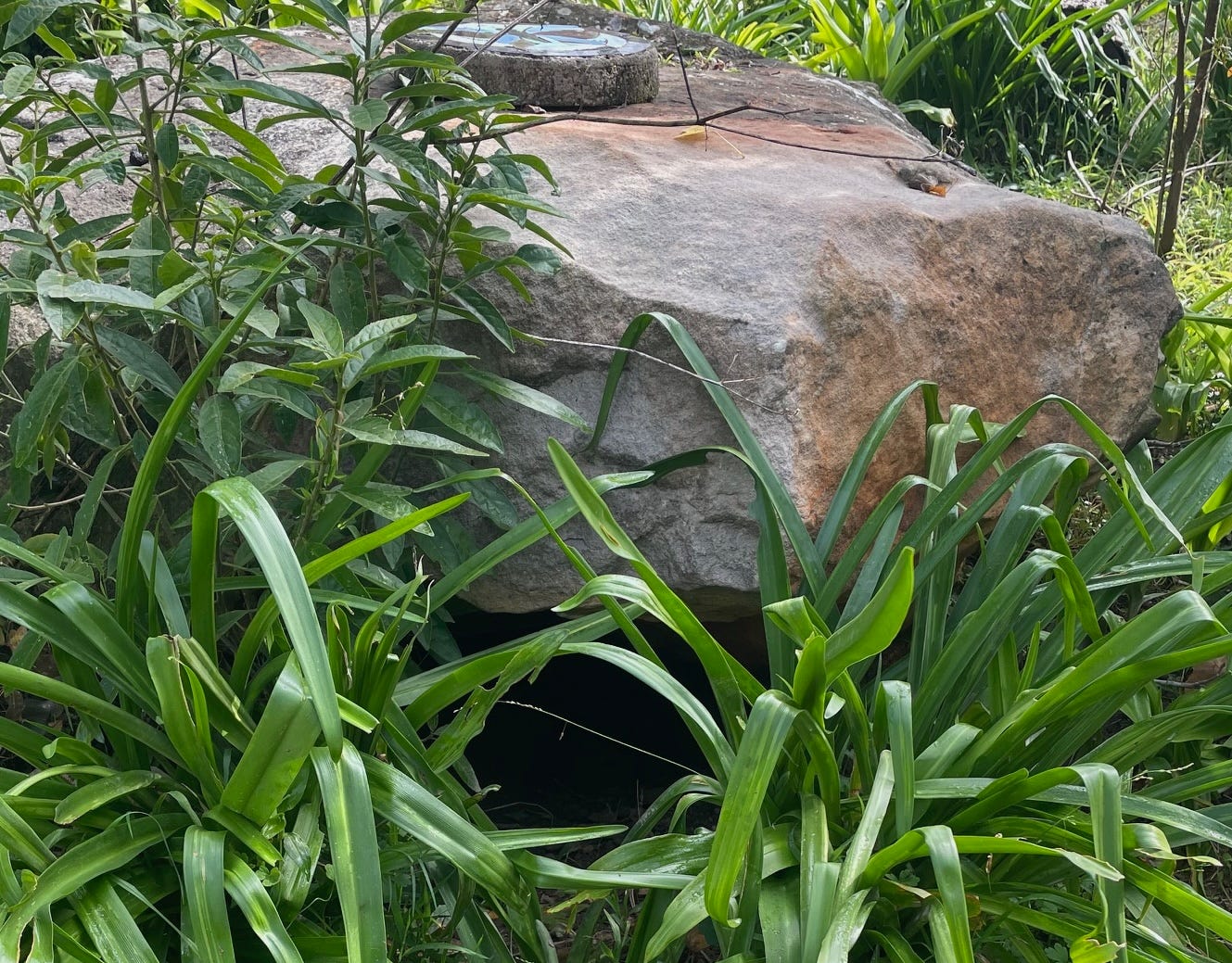The good news is that we have lots of wombats at Kawalang. There are wombats on top of our sandstone ridge near the house and a whole village of wombats in our valley where a tiny creek provides a flood plain.
The flood plain in the valley is rarely flooded, so a group of wombats built an extensive set of tunnels on the flat, well above the water line. When we had an very unusual wet period that lasted almost a full year, a tiny dry creek became a small creek again and proceeded to flood the wombat village. Sometimes flooded burrows can be dangerous for the wombats, but I suspect our creek flat was not life threatening because the wombats abandoned their homes and moved to higher ground to re-establish their abodes.
Wombats are industrious and it seems that they can tire of a particular abode because there always seems to be construction going on, especially on the creek flats where there are no rocks to make burrow construction tedious.
Wombats and mange
The bad news is that our district has mange, a skin disease caused by the mite Sarcoptes scabiei which gets under the skin and causes itching and loss of condition of the wombats. This is debilitating when it gets serious and the wombats die. A clear sign of trouble is when a wombat (normally nocturnal) comes out during the afternoon to graze.
A local wombat with initial signs of mange
Treating wombats for mange
There are various ways for treating wombats. One involves hanging a flap container with miticide over the wombat burrow entrance so that when the wombat enters or exits, it gets treated via miticide on its back. We have so many wombat burrows that this approach isn’t very practical. So I’ve adopted the patient stalking approach. Wombats don’t like you approaching them head on, but if you are patient, calm and non-threatening, it is possible to get close to these wild animals by approaching them from behind. They also are susceptible to thinking that they are invisible if they shelter in shrubbery.
Wombats are adventurous where they make burrows and we have an attempted burrow close to our house. I say “attempted” because this burrow was started under a large sandstone rock in an area where there are very large sandstone rocks.
Wombat burrow that goes nowhere
Wombats are very persistent, but this burrow has proved too challenging for our local wombats, so it is a dead end that allows a wombat to get its head and a significant part of its body inside, but its back is quite visible for me to approach. The sheltering wombat thinks I can’t see it. This is my best wombat treating spot, because the wombat has no way of escaping my treatment. Treating out in the open is slow and often fails (wombats can take off and there is no catching them!) but it can be done.
My treatment stick is basically a broom handle with a 150 ml plastic bottle containing miticide attached to the end. I fail a lot, but when sick wombats come out in the open during the day, it is possible to treat them.
The problem is that ideally one treats the wombat weekly over several weeks as the miticide does not kill resistant stages of the mites. Weekly treatment eventually gets them all. Mostly I find that I only get a chance for a couple of treatments as the wombats obviously feel better and hence resume their normal nocturnal habits.
Wombats are not easily put off
I discovered how determined a wombat can be when a wombat discovered how to break into our growing area which is bounded by a kangaroo & wombat proof fence. This is a substantial piece of fencing with a strong 2 meter high wire mesh fence that is folded at the top to discourage kangaroos jumping over. The wombats are deterred by an underground horizontal wire grid ~1/2 meter wide below the vertical fence. The grid is connected to the upright fence by substantial wire clips. We lived happily for 4 years with no incursions by wombats or kangaroos… until one day the wombat discovered that s/he could loosen the attaching clips and break in.
Wombat break-in. Note very solid grid underneath the fence and destruction of the substantial vertical fencing by the wombat. If you look closely you’ll see where the connection between the fence and underneath grid has been re-established
The pattern was that the wombat would break in at the bottom of a hill adjacent to bushland and then move up to the top of the hill during the night. Presumably the wombat forgot where it had broken in, because invariably there was a breakout spot at the top of the hill. For a period of a whole month I would inspect last evening’s activities and find and repair both break-in and break-out areas. This became a game, because it happened a LOT! Only after I had repaired just about the whole several hundred meters of fencing over the course of two months did the wombat finally give up!
It is a big relief that peace has broken out in the wombat battles and life has returned to normal. We get frequent visits around the house (which is outside of our fenced growing area) in the evening. Our Labrador dog is respectful of wombats and vice versa. It is all good fun establishing peace with the wild creatures whose home we share.






